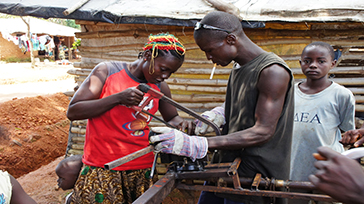Technical briefs
-
Can we measure the school-to-work transition of young persons with labour force surveys? A feasibility study
18 November 2016
Data gathering in SWTSs is based on retrospective questions addressed to young persons aged 15 to 29 years old. Many of the key elements of the survey can also be found in conventional labour force surveys. The question then arises as the extent to which the results of the SWTS can also be obtained from conventional labour force surveys.
-
What are the effects of job polarization on skills distribution of young workers in developing countries?
10 November 2016
One of the most discussed topics in the domain of labour economics during the last couple of decades has been the polarization of employment in industrialized countries, namely the growth of high and low paying jobs and the decline of jobs paying wages around the middle of the wage distribution.
-
Inequality of opportunity and (unequal) opportunities in the youth labour market: How is the Arab world different?
04 November 2016
Using the recent school-to-work transition surveys for Egypt, Jordan and Tunisia, the Technical Brief address the unique phenomenon in the Middle East and North Africa region of disproportionately high levels of unemployment among educated young people.
-
The role of internal migration in access to first job: A case study of Uganda
06 October 2016
Does internal migration hasten labour market access for young women and men? This paper analyses data from the school-to-work transition survey in Uganda to address the topic. The main indicator used is the transition length to a first job with comparison made between young people in Uganda that have migrated inside the country and those who have never changed their residence.
-

Does the work-study combination among youth improve the transition path? An updated review
07 July 2016
The present brief, following the one issued in November 2015, has attempted to revisit some of the results on the work-study combination of youth, using the new data from the School-to-work- transition surveys carried out in 2014/15. The main result found in the previous brief, namely that working while studied increased the probability of a successful transition, is confirmed using the new round of data.
-

© ILO 2024
Organizing of young informal workers: Does it pay off?
18 April 2016
There are several questions to be answered, as far as the nature, dynamics and ramifications of organized action among young informal workers. This paper attempts to answer these questions from a comparative perspective of Uganda and Nepal. Based on the analysis of the School-to-work transition surveys (SWTS), this paper identifies several underlying determinants of the likelihood of a young informal worker’s participation in associational activities.
-

Does the work-study combination among youth improve the transition path?
10 November 2015
Can working while studying act as a stepping stone to good labour market opportunities or is it rather a necessity-driven constraint of more vulnerable youth, taking focus away from studying? The objective of the present technical brief is to reflect on the role played by the work-study combination in the transition to stable and satisfactory employment.
-

What does NEETs mean and why is the concept so easily misinterpreted?
06 February 2015
This technical brief, based on an analysis of the recent School-to-work transition surveys (SWTS) from 28 low- and middle-income countries, hopes to contribute to a better understanding of the NEETS indicator.